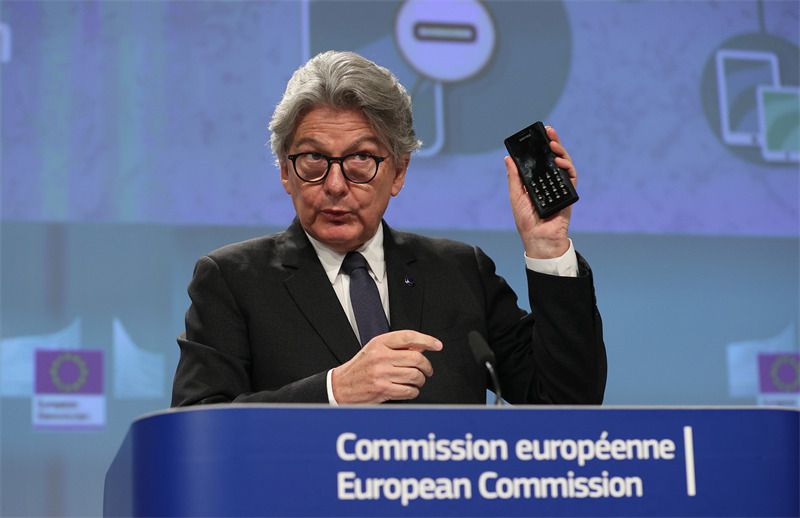
Not long ago, the European Commission announced a bill suggesting that it plans to use the USB-C interface as a universal charging interface for all electronic devices such as smartphones, tablets, cameras, headphones, speakers, and video game consoles in the European Union. After the passage of this legislation, electronic equipment manufacturers will have a transition period of 2 years to make relevant adjustments.

Why does the EU want a unified interface?
- Improve the convenience of life - The European Commission stated, various manufacturers have different specifications for the charging interface of electronic devices for a long time, causing waste of electronic resources and inconvenience to consumers. Unified charging interface will increase convenience for life and help promote the EU's green and digital transformation at the same time.
- Reduce electronic waste - Currently, each EU citizen has an average of 3 pieces charging cables, and only two are used frequently. The unified charging cable can reduce 1,000 tons of electronic waste every year.
- Reduce greenhouse gases - According to the statistics by EU commission, the annual production of charging cables will produce 180 kilotons of carbon dioxide equivalent and other pollutants.
What are the current interfaces?
There are currently 4 kinds of mainstream charging ports for electronic device: Mini USB, Micro USB, USB-C and Lightning.

- Mini USB - This USB interface is earliest popular and still widely used in small home appliances such as power banks, LED lights, learning machines, music players, digital cameras, and digital products.
- Micro USB - Micro USB is a USB 2.0 portable version that came out in 2007. Compared with the previous mini USB, it is thinner and has a faster transmission rate. It is called "Android port" by the public. It is mainly used in low- and medium-priced Android phones.

- USB-C - As a USB 3.0 product, the highlight of Type-C is the transmission speed up to 10Gbps and the power transmission up to 100W. Positive and negative pluggable, and its strong expandability allows it to be connected to PC, game consoles, smart phones, and storage devices. Standardized interface with all electronic devices such as docking station. In September 2021, the USB-IF organization released the latest USB Type-C interface and cable v2.1 version of the standard protocol. The power supply capacity has been increased from 100W to 240W. In the future, gaming laptop even not need a separate power adapter.

- Lightning - The Lightning interface is an exclusive connector specification developed by Apple, which first appeared at the iPhone 5 conference in 2012. But only the speed of USB 2.0, the transfer rate is about 25-35MB/s. The magic is that Apple’s new MacBook give up the magnetic interface that has been used for many years and switched to USB-C. Combining the above comparisons, USB-C may be the general trend.

Behind the seemingly convenient, there are a lot of inconveniences hidden
The ideal is full, but the reality is very skinny. Of course, the idea of a unified charger is very good, but will the realization process bring any obstacles?
Apple was the first to bear the brunt As early at 10 years ago, the European Union had mandated that Apple use micro USB as a charging standard. Apple subsequently bypassed this regulation by providing a micro USB to Lightning adapter.
To comply with the bill, entire line of Apple products must abandon the use of its own developed Lightning. Although Apple has adopted the USB-C interface on iPad mini 6 and other devices, but iPhone 13 series is still use Lightning.
There are rumors that Apple hopes to use wireless charging to achieve a completely portless iPhone.
Many designs need to start from scratch
Hinder design innovation - Apple has said that if the connector is forced to be unified into one specification, it will hinder innovation.
Many designs need to start from scratch - The size is different of each charging interface. If all of them are replaced with USB-C, the shell and the interior must be redesigned.
Take Apple(buttom one) and Xiaomi (top one) phones as examples. The size of the USB-C interface is obviously larger than that of Lightning. In the field of precision parts processing, the unit of precision is μm*, and minor size changes are creating problems for engineers. *Note: 1 centimeter (cm)=10,000 microns (μm)
The size is changes of the frame hole, and the corresponding internal component arrangement will also change.
Users will face charging shortage
Consumers and manufacturers are bearing the inconvenience caused by the "big change". Taking smart phones as an example, the general service life is more than 2 years, and users who have just purchased a new phone will face problems such as replacement and maintenance of related accessories. It is impossible to ensure whether there are relevant spare parts inventory and maintenance personnel after 2 years. The original manufacturers after 2 years may have given up the production parts.
Supplier mass production charger
On the one hand, the batteries, charger and cables that are not compatible with USB-C will be "eliminated", and stock goods are directly turned into electronic waste from supplier. On the other hand, China is the world's factory, and most of the world's parts and components are produced in China. The EU's move may cause a sharp increase orders in USB-C product, which in turn will cause suppliers to compete to open new production lines. Once production to much, it is easy to produce e-waste, which is not a good thing for China's environmental development.
For more industry news, please continue to pay attention to IETCHARGER.


